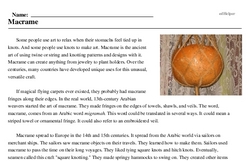Macrame
Some people use art to relax when their stomachs feel tied up in knots. And some people use knots to make art. Macrame is the ancient art of using twine or string and knotting patterns and designs with it. Macrame can create anything from jewelry to plant holders. Over the centuries, many countries have developed unique uses for this unusual, versatile craft.
If magical flying carpets ever existed, they probably had macrame fringes along their edges. In the real world, 13th-century Arabian weavers started the art of macrame. They made fringes on the edges of towels, shawls, and veils. The word, macrame, comes from an Arabic word migramah. This word could be translated in several ways. It could mean a striped towel or ornamental fringe. It could also refer to an embroidered veil.
Macrame spread to Europe in the 14th and 15th centuries. It spread from the Arabic world via sailors on merchant ships. The sailors saw macrame objects on their travels. They learned how to make them. Sailors used macrame to pass the time on their long voyages. They liked tying square knots and hitch knots. Eventually, seamen called this craft "square knotting." They made springy hammocks to swing on. They created other items for the ship. They even used the items they made for trade when they went ashore.




